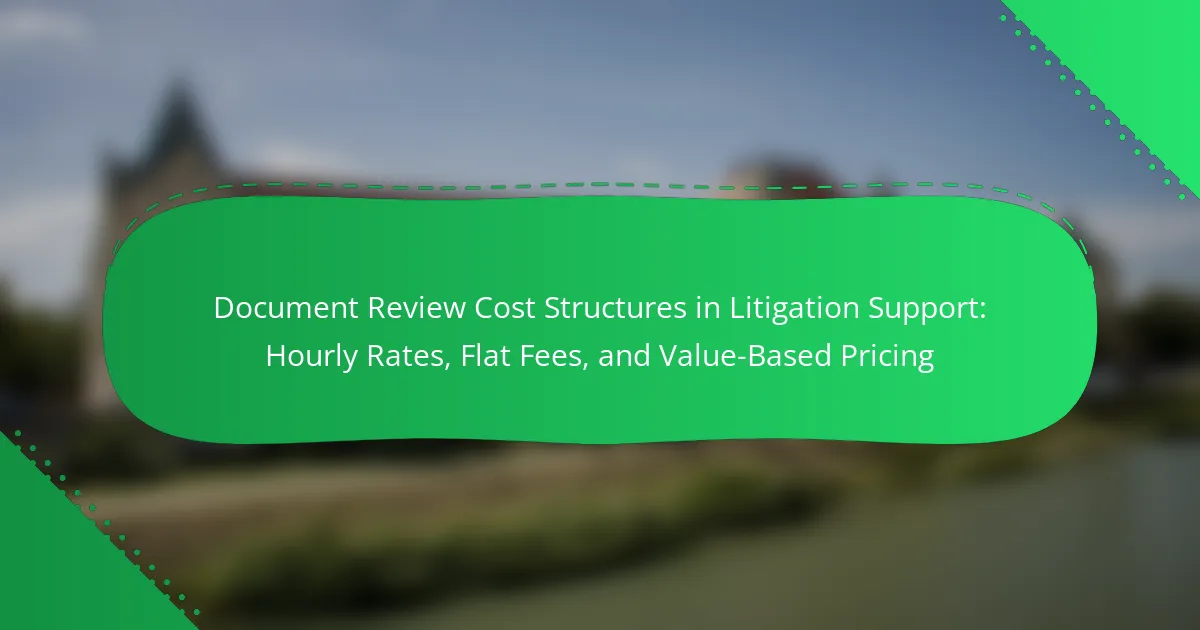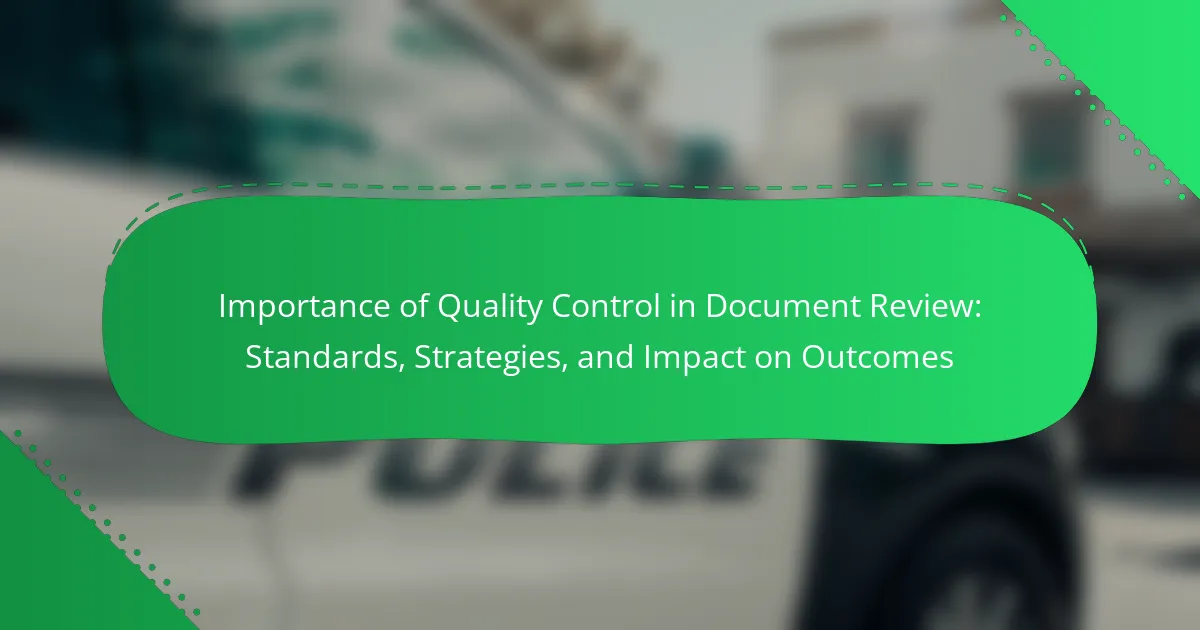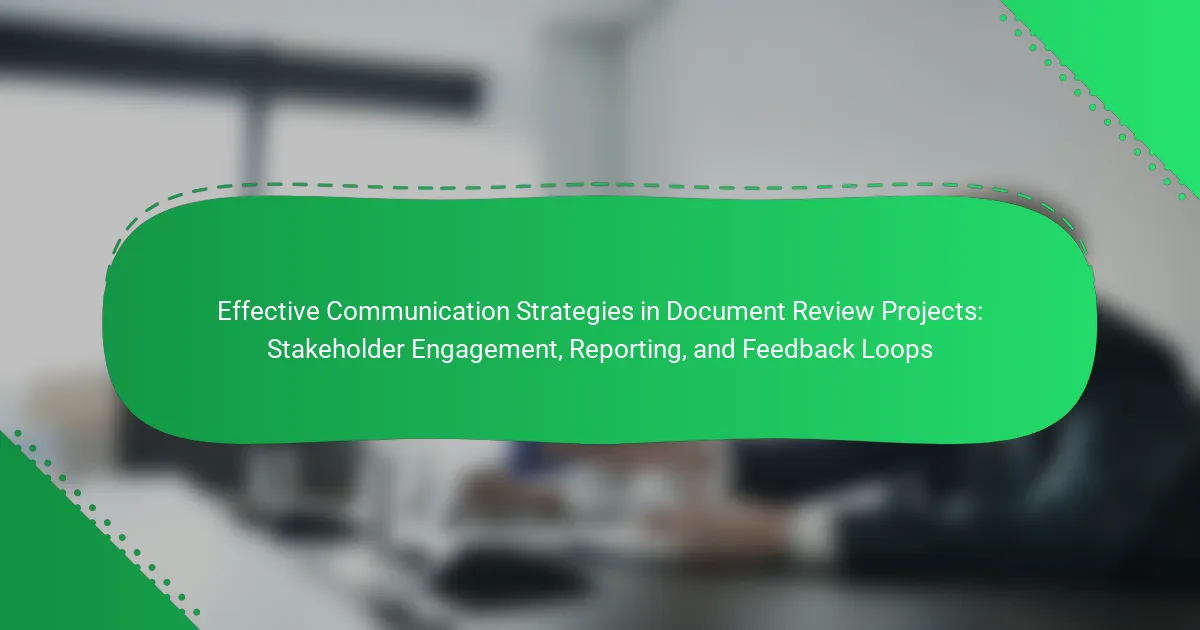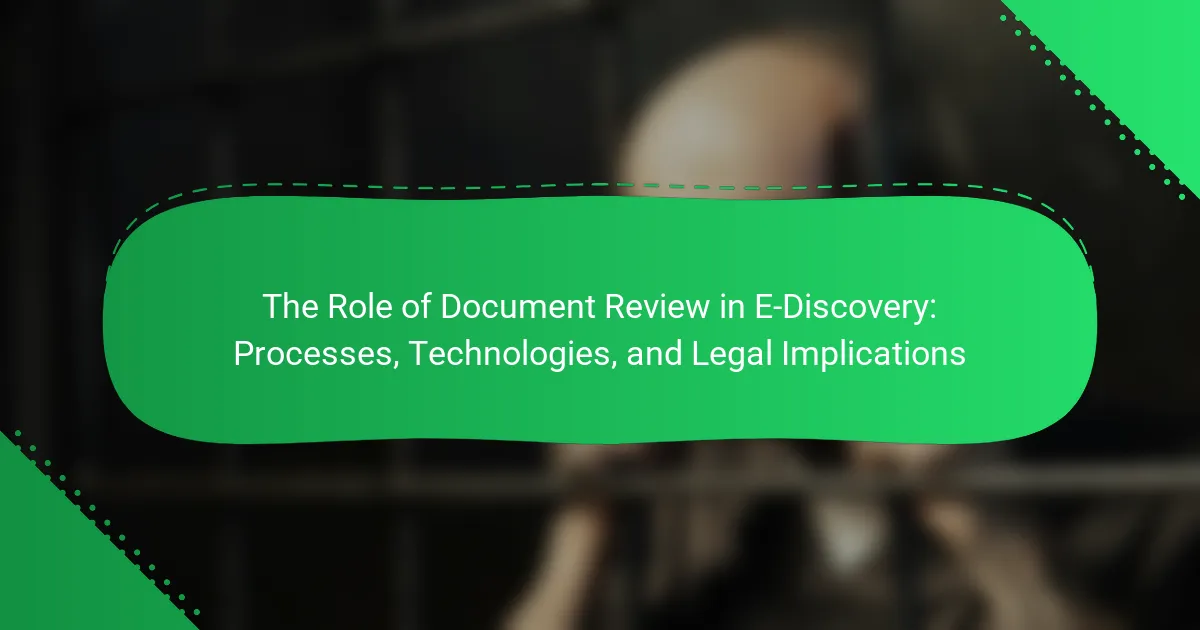Document review cost structures in litigation support encompass the various pricing models employed for the analysis of legal documents. The primary models include hourly rates, flat fees, and value-based pricing. Hourly rates involve charging clients for each hour dedicated to document review, while flat fees provide a predetermined cost for the entire review process. Value-based pricing connects the cost to the perceived value of the service, rather than merely the time or volume of work involved. Understanding these cost structures is essential for clients to effectively budget for legal services and make informed decisions regarding litigation support.
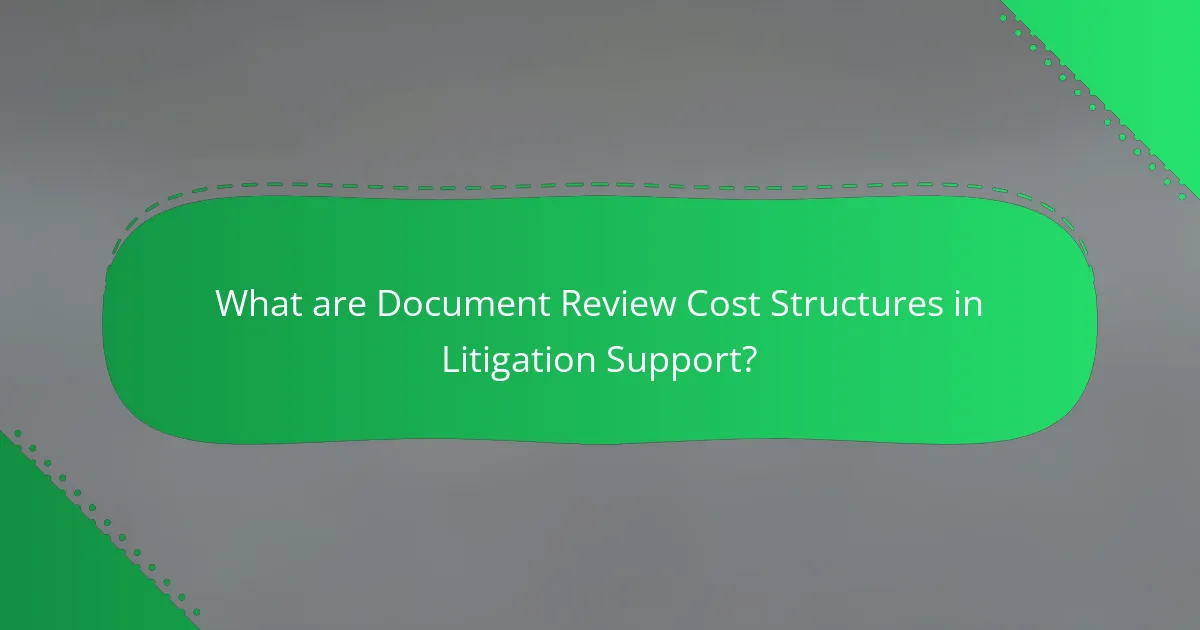
What are Document Review Cost Structures in Litigation Support?
Document review cost structures in litigation support refer to the pricing models used for reviewing legal documents. These structures typically include hourly rates, flat fees, and value-based pricing. Hourly rates are common, where legal professionals charge for each hour spent on document review. Flat fees involve a set price for the entire document review process, regardless of time spent. Value-based pricing ties costs to the perceived value of the service provided, rather than just time or volume of work. Each structure has its advantages and can impact the overall cost of litigation support. Understanding these structures helps clients budget effectively for legal services.
How do Hourly Rates function in Document Review Cost Structures?
Hourly rates serve as a primary method for calculating costs in document review processes. These rates are typically charged per hour of work performed by legal professionals. The total cost is determined by multiplying the hourly rate by the number of hours worked on the document review.
Factors influencing hourly rates include the experience and expertise of the reviewers. More experienced professionals usually command higher rates. Additionally, the complexity of the documents being reviewed can affect the time required and, consequently, the total cost.
In litigation support, hourly rates provide flexibility. Clients can adjust the number of hours based on their budget and needs. This method also allows for transparency in billing, as clients can see the time spent on specific tasks.
According to a survey by the Association of Certified E-Discovery Specialists, hourly rates for document review can range from $50 to $300 per hour, depending on various factors. This data supports the understanding of how hourly rates function in document review cost structures.
What factors influence Hourly Rates in litigation support?
Hourly rates in litigation support are influenced by several key factors. Experience level of the professionals involved is a primary determinant. More experienced professionals typically command higher rates due to their expertise. Geographic location also plays a significant role. Rates can vary widely between urban and rural areas.
The complexity of the case affects hourly rates as well. More intricate cases often require specialized knowledge, resulting in higher fees. Additionally, the type of litigation support services offered influences pricing. Services such as document review, expert testimony, or trial preparation may have different rate structures.
Market demand for litigation support services can impact hourly rates. In high-demand areas, rates may increase due to competition for skilled professionals. Lastly, the reputation of the firm providing the support can lead to variations in rates. Firms with strong track records may charge premium prices for their services.
How do Hourly Rates compare across different firms?
Hourly rates vary significantly across different firms. Factors influencing these rates include firm size, location, and expertise. Larger firms often charge higher rates due to their reputation and resources. For instance, rates can range from $150 to over $500 per hour. Geographic location also plays a crucial role; firms in major cities typically have higher rates than those in smaller markets. Additionally, specialized firms may command premium rates based on their niche expertise. Overall, a comprehensive analysis reveals that hourly rates are not uniform and depend on multiple variables within the legal and litigation support landscape.
What are Flat Fees in Document Review Cost Structures?
Flat fees in document review cost structures refer to a predetermined total charge for reviewing documents. This pricing model contrasts with hourly rates, providing clients with a clear and fixed cost. Flat fees simplify budgeting for legal services related to document review. They are particularly beneficial for projects with a defined scope and volume of documents. Clients can avoid unexpected costs that may arise from hourly billing. This pricing approach encourages efficiency and can lead to quicker project completion. Flat fees are commonly used in litigation support to enhance transparency and predictability in legal expenses.
What are the advantages of using Flat Fees in litigation support?
Flat fees in litigation support offer several advantages. They provide cost predictability for clients. Clients know the total expense upfront, reducing financial uncertainty. This structure encourages efficient work, as attorneys focus on completing tasks rather than billing hours. Flat fees can enhance client satisfaction through transparency in pricing. They also streamline the budgeting process for legal expenses. Additionally, flat fees may lead to quicker resolution of cases, as there is less incentive to prolong work. This pricing model can foster a stronger attorney-client relationship by aligning interests. Overall, flat fees promote efficiency and clarity in litigation support.
How are Flat Fees determined for document review projects?
Flat fees for document review projects are determined based on the scope and complexity of the project. Factors include the volume of documents, the level of review required, and the timeline for completion. Service providers assess these elements to estimate the total cost. They may also consider the expertise required for the review. Historical data from similar projects can inform pricing models. Additionally, market rates and competitive analysis play a role in setting flat fees. This structured approach ensures that clients receive predictable costs for their document review needs.
What is Value-Based Pricing in Document Review Cost Structures?
Value-based pricing in document review cost structures is a pricing strategy that aligns the cost of services with the value delivered to clients. This approach considers the client’s perception of value rather than the cost of providing the service. It allows legal service providers to set prices based on the outcomes achieved for clients. For instance, if a document review significantly reduces litigation risk, the price may reflect that benefit. This pricing model can enhance client satisfaction and foster long-term relationships. Research indicates that firms using value-based pricing often see improved profitability and client retention.
How does Value-Based Pricing differ from Hourly Rates and Flat Fees?
Value-Based Pricing focuses on the perceived value delivered to the client, rather than the time spent or a fixed fee. Hourly Rates charge clients based on the number of hours worked, making costs variable and directly tied to time. Flat Fees, on the other hand, set a predetermined price for a service, regardless of the time or resources used.
In contrast, Value-Based Pricing aligns the cost with the outcome and benefits received by the client. This approach can lead to higher satisfaction as clients pay for results rather than time. Research shows that businesses using Value-Based Pricing often achieve better profit margins compared to those relying solely on Hourly Rates or Flat Fees.
What are the benefits of adopting Value-Based Pricing?
Value-Based Pricing allows businesses to align their pricing strategy with the perceived value of their products or services. This approach enhances customer satisfaction as clients feel they are paying for the value received. Companies often experience increased profitability as they can charge higher prices for high-value offerings. By focusing on customer needs, businesses can improve their market positioning. Research shows that companies adopting this pricing model often see a boost in customer loyalty. A study by the Harvard Business Review found that businesses utilizing value-based pricing can achieve up to a 20% increase in revenue. This method also encourages innovation, as companies seek to enhance their offerings to justify higher prices. Ultimately, Value-Based Pricing fosters a deeper understanding of customer preferences and market dynamics.
How do Document Review Cost Structures impact overall litigation expenses?
Document review cost structures significantly impact overall litigation expenses. These structures determine how much clients pay for document analysis during legal proceedings. Hourly rates can lead to unpredictable costs based on the time spent on review. Flat fees offer a fixed cost, providing budget certainty but may not reflect actual time needed. Value-based pricing aligns costs with the case’s complexity and potential outcomes, potentially reducing unnecessary expenses. According to a study by the RAND Corporation, effective document review strategies can cut litigation costs by 20% to 30%. Thus, the choice of cost structure directly influences financial outcomes in litigation.
What trends are influencing Document Review Cost Structures in the legal industry?
Trends influencing document review cost structures in the legal industry include automation, increased reliance on technology, and alternative billing models. Automation reduces the time lawyers spend on document review. Technologies like artificial intelligence enhance efficiency in identifying relevant documents. Increased competition among law firms pressures them to adopt cost-effective solutions. Additionally, clients are increasingly favoring flat fees over hourly rates. This shift encourages law firms to streamline processes and reduce costs. Value-based pricing models are emerging as firms seek to align fees with client outcomes. Collectively, these trends are reshaping the financial landscape of legal document review.
What best practices can be applied to manage Document Review Costs effectively?
Implementing a structured approach is essential to manage Document Review Costs effectively. First, establish clear guidelines for document review processes. This includes defining the scope and objectives of the review. Second, utilize technology such as e-discovery tools to streamline the review process. These tools can significantly reduce time and costs associated with manual reviews. Third, train staff thoroughly on best practices in document review. Well-trained personnel can identify relevant documents more efficiently. Fourth, consider outsourcing to specialized firms when necessary. Outsourcing can provide expertise and reduce overhead costs. Finally, regularly review and analyze costs associated with document reviews. This analysis can help identify areas for improvement and cost-saving opportunities. According to a study by the American Bar Association, effective management strategies can reduce document review costs by up to 30%.
Document review cost structures in litigation support encompass pricing models such as hourly rates, flat fees, and value-based pricing. Each model has distinct characteristics that influence overall litigation expenses, with hourly rates providing flexibility based on time spent, flat fees offering predictable costs for defined scopes, and value-based pricing aligning costs with the perceived value of outcomes. Factors affecting these structures include the experience of legal professionals, geographic location, and the complexity of cases. Understanding these cost structures is essential for clients to effectively budget for legal services and manage litigation expenses.
